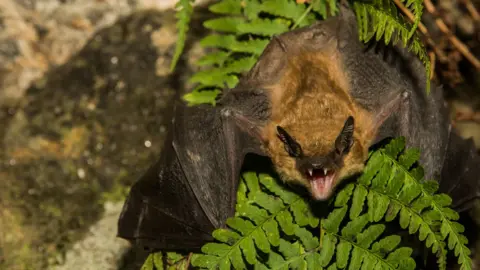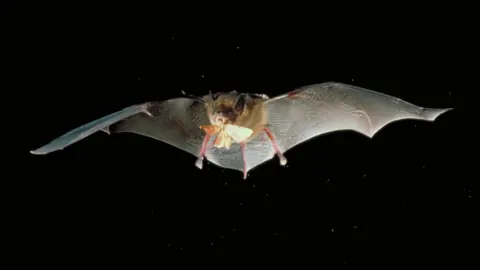How bats keep an ear on their prey
 Getty Images
Getty ImagesA structure that allows sound information to be processed extremely fast has been identified in bats' brains.
Researchers were able to analyse the echo-locating animals' neurones as they caught their insect prey in darkness.
But the bats have to process a lot of sound information.
"The vocalisations are insanely fast. It is a heavy processing load to perform this behaviour," said Dr Melville Wohlgemuth, who led the study.
The research is published in the journal JNeurosci.
The scientists wanted to find out whether this need to process over 120 sound clicks per second had resulted in the evolution of a more efficient brain structure.
Dr Wohlgemuth located the "superior colliculus" structure in the bats' brain. This is the area of the brain that lets the bat know where things are in relation to themselves. He found that in the bats, this structure is uniquely adapted to analyse auditory data quickly and enable quick and accurate corrections of the body in response.
In order to catch the insects, bats have to know where their body is, and put that in the context of where their prey is. And they need to do this fast.
The neurones that help them process spatial and motor information were found to be very close together. This close proximity is likely to be what allows them to quickly process the echoes bouncing back from their prey.
Brain recording
In most mammals, the brain structure identified in these bats is more closely associated with vision. When you move your eyes across the page, the precision with which you find the next word is dictated by this structure in the centre of your own brain.
"It's about focusing," said Dr Wohlgemuth of the superior colliculus. For this study, his team trained a wild Big Brown Bat to sit still and wait for a food reward to arrive on a zip wire.
They set up microphones around the animal to record what sounds the bats emitted with the prey approaching at different angles. They then checked which part of the brain was most active during this food capturing process.
"We inserted a recording device into the brain, and then we recorded activity from individual neurones," said Dr Wohlgemuth.
Using this method, they saw the superior colliculus reacting extremely quickly to the click echoes of the bats' calls.
Dr Wohlgemuth was able to conclude that the uniquely close proximity of specialist location neurones and motor neurones in this brain structure are used by the bats to process the information at a fast rate.
 SPL
SPLThis allows them to catch the insect and feed. But the study allowed researchers to peer through the messy signals prevalent in mammalian brains.
"The real benefit of using the bats is that we can just measure how quickly the animal is vocalising so we have a quantitative measure of how much information that animal is taking in at that time," said Dr Wohlgemuth.
"For the bat we know this very precisely because we can just measure how quickly it is vocalising and so taking in information," he continued. "It has to take in lots of information and crunch that data very quickly to do something with it."
Bats adapted the system used for vision for other mammals to enable them to catch flying insects in darkness.
This was an incredibly successful evolutionary innovation for the animals, which now inhabit every continent but Antarctica. There are around 1,000 different bat species, more than there are of any other group of mammal.
